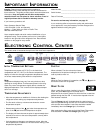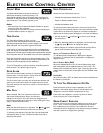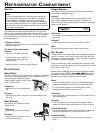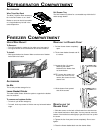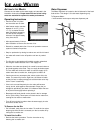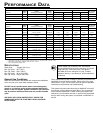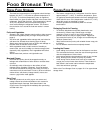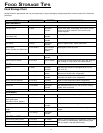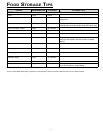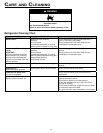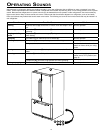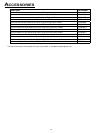
8
9
fo o d St o r a g e tI p S
fr e S h fo o d St o r a g e
• Thefreshfoodcompartmentofarefrigeratorshouldbekept
between 34°-40°F (1°-4°C) with an optimum temperature of
37°F (3°C). To check the temperature, place an appliance
thermometer in a glass of water and place in the center of the
refrigerator. Check after 24 hours. If the temperature is above
40°F (4°C) adjust the controls as explained on page 2.
• Avoidovercrowdingtherefrigeratorshelves.Thisreduces
the circulation of air around the food and results in uneven
cooling.
Fruits and Vegetables
• Storageinthecrisperdrawerstrapshumiditytohelppreserve
thefruitandvegetablequalityforlongertimeperiods(see
page 4).
• Sortfruitsandvegetablesbeforestorageandusebruisedor
soft items first. Discard those showing signs of decay.
• Alwayswrapodorousfoodssuchasonionsandcabbageso
the odor does not transfer to other foods.
• Whilevegetablesneedacertainamountofhumidityto
remain fresh, too much humidity can shorten storage times
(especially leafy vegetables). Drain vegetables well before
storing.
• Waittowashfreshproduceuntilrightbeforeuse.
Meat and Cheese
• Rawmeatandpoultryshouldbewrappedsecurelyso
leakage and contamination of other foods or surfaces does
not occur.
• Occasionallymoldwilldeveloponthesurfaceofhard
cheeses(Swiss,Cheddar,Parmesan).Cutoffatleastan
inch around and below the moldy area. Keep your knife or
instrument out of the mold itself. Do not try to save individual
cheese slices, soft cheese, cottage cheese, cream, sour
cream or yogurt when mold appears.
Dairy Food
• Mostdairyfoodssuchasmilk,yogurt,sourcreamand
cottage cheese have freshness dates on their cartons for
appropriatelengthofstorage.Storethesefoodsinthe
original carton and refrigerate immediately after purchasing
and after each use.
fr o z e n fo o d St o r a g e
• Thefreezercompartmentofarefrigeratorshouldbekeptat
approximately 0°F (-18°C). To check the temperature, place
an appliance thermometer between the frozen packages and
check after 24 hours. If the temperature is above 0°F (-18°C),
adjust the control as described on pages.
• Afreezeroperatesmoreefficientlywhenitisatleast
two-thirds full.
Packaging Foods for Freezing
• Tominimizedehydrationandqualitydeteriorationuse
aluminum foil, freezer wrap, freezer bags or airtight
containers. Force as much air out of the packages as
possible and be sure they are tightly sealed. Trapped air
can cause the food to dry out, change color and develop an
off-flavor (freezer burn).
• Wrapfreshmeatsandpoultrywithsuitablefreezerwrapprior
to freezing.
• Donotrefreezemeatthathascompletelythawed.
Loading the Freezer
• Avoidaddingtoomuchwarmfoodtothefreezeratonetime.
This overloads the freezer, slows the rate of freezing and can
raise the temperature of frozen foods.
• Leavespacebetweenthepackagessocoldaircancirculate
freely,allowingfoodtofreezeasquicklyaspossible.
• Avoidstoringhard-to-freezefoodssuchasicecreamand
orange juice on the freezer door shelves. These foods are
best stored in the freezer interior where the temperature
varies less with door openings.
RefertotheFoodStorageChartonpages10-11forapproximate
storage times.




